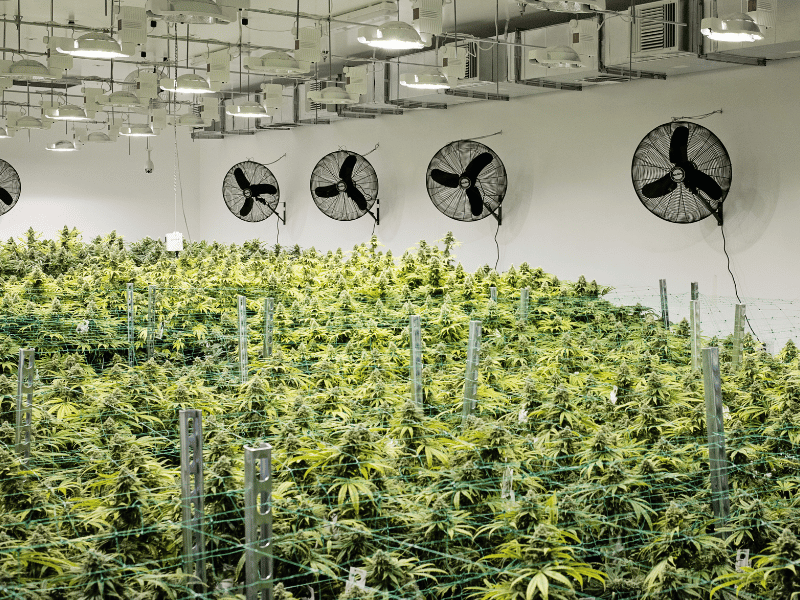Easy to order great service great product equals very happy customer
Trellis Netting for Cannabis: Best Practices for Home & Commercial Grows

Trellis netting is an essential tool for cannabis cultivators looking to maximize yields, improve airflow, and support plant structure. Whether you're growing in a small home setup or managing a large-scale commercial operation, using trellis netting correctly can significantly enhance the quality and quantity of your harvest.
This guide will break down why trellis netting is important, the best ways to implement it, and how to choose the right type for your grow space.

1. Why Use Trellis Netting for Cannabis?
Trellis netting is used to train and support cannabis plants throughout their life cycle. It allows growers to control plant height, improve canopy exposure to light, and prevent branches from snapping under the weight of heavy buds.
✅ Key Benefits of Trellis Netting
✔ Maximizes Yield – More light exposure means larger, more uniform buds.
✔ Improves Airflow – Reduces humidity pockets that can cause mold & mildew.
✔ Supports Heavy Buds – Prevents branches from breaking under weight.
✔ Encourages Lateral Growth – Helps plants spread out instead of growing too tall.
✔ Saves Space – Helps train plants into an efficient, structured canopy.
Whether you’re growing a few plants in a tent or managing rows of commercial cannabis, trellising helps create a more organized and productive grow.
2. Types of Trellis Netting & When to Use Them
There are two primary types of trellis netting used in cannabis cultivation:
🌱 Soft Trellis Netting (Elastic or Nylon)
-
Best for: Indoor & greenhouse grows
-
Used for: Low-Stress Training (LST), ScrOG setups, plant spacing
-
Pros: Flexible, reusable, and easy to adjust
-
Cons: Not as strong for large-scale grows
🌱 Rigid Trellis Netting (Plastic or Metal)
-
Best for: Outdoor & large-scale commercial grows
-
Used for: Heavy bud support, vertical growth, and multiple harvest cycles
-
Pros: Durable, strong, withstands outdoor elements
-
Cons: Less flexible, harder to remove or adjust
Choosing the right type of netting depends on your grow setup. For home growers, soft trellis netting works well. For commercial grows, rigid netting offers long-term durability.

3. How to Set Up Trellis Netting in a Grow Tent
For home growers using a grow tent, trellising is a great way to train plants and optimize space. Here’s how to do it:
🌱 Step 1: Install the Trellis Before Flowering
-
Attach trellis netting to the tent frame about 12 inches above the plants.
-
Ensure it is tight and level for even plant training.
🌱 Step 2: Weave Branches Through the Netting
-
As plants grow, gently tuck branches under the netting to encourage lateral spread.
-
Avoid tying plants too tightly—allow some natural movement.
🌱 Step 3: Add a Second Layer of Netting (Optional)
-
If plants stretch a lot during flowering, install a second trellis 8-12 inches above the first.
-
This will help support heavy colas as buds develop.
🌱 Step 4: Prune & Maintain Canopy Structure
-
Trim lower leaves to improve airflow.
-
Monitor plant growth weekly to keep the canopy even.
Trellising in a grow tent helps keep plants manageable, improves light distribution, and supports larger yields.
4. Best Practices for Trellising in Commercial Grows
Large-scale cultivators use trellising to create uniform canopies and boost harvest efficiency. Here’s how to do it at scale:
🏢 Vertical Trellising for Commercial Cannabis
For outdoor and greenhouse operations, vertical trellising allows cannabis plants to grow upward along sturdy netting.
✔ Install trellis netting between rows to support tall plants.
✔ Use heavy-duty plastic or metal netting for durability.
✔ Train plants early to prevent overcrowding.
🏢 Multi-Tier Trellising for High-Yield Setups
Large-scale indoor grows often use multiple layers of trellis netting for stability.
✔ First layer (vegetative stage): Spreads plant branches for even canopy growth.
✔ Second layer (flowering stage): Supports bud weight and prevents branch breakage.
✔ Third layer (optional, for heavy strains): Ensures maximum support for large colas.
Commercial growers benefit from automated trellis systems that make it easier to adjust netting across multiple rooms.

5. Common Mistakes & How to Avoid Them
🚫 Trellising Too Late – Always install trellis netting before plants start stretching in flower.
🚫 Tying Plants Too Tightly – Allow branches to move slightly for better airflow and flexibility.
🚫 Neglecting Canopy Management – Regularly tuck and train plants to prevent overcrowding.
🚫 Using the Wrong Netting – Match netting strength to plant size (soft for light plants, rigid for heavy strains).
Avoiding these mistakes ensures that trellising improves plant health instead of restricting growth.
6. Where to Buy the Best Trellis Netting for Cannabis
High-quality trellis netting is a must-have for serious growers. Look for netting that is:
✔ Strong & Durable – Can handle the weight of large colas
✔ Easy to Install & Adjust – Allows for flexible plant training
✔ Mildew & Moisture Resistant – Prevents mold growth in humid environments
Recommended Suppliers
🔹 454 Bags – Offers heavy-duty trellis netting for commercial and home growers.
🔹 Hydrofarm – Trusted for high-quality grow equipment.
🔹 Amazon & Grow Shops – Good options for small-scale setups.
Investing in high-quality trellis netting pays off with bigger yields, healthier plants, and a more efficient grow space.
7. Final Takeaways: Trellising for a Bigger, Better Harvest
Trellis netting is one of the best tools for cannabis growers looking to improve structure, airflow, and bud development.
💡 Key Takeaways:
✅ Use soft netting for indoor grows, rigid netting for outdoor & commercial setups.
✅ Install early (before flowering) for best results.
✅ Weave branches through the net to train plants for maximum light exposure.
✅ Use multiple layers of trellis for large, heavy-producing strains.
✅ Monitor plant growth weekly to prevent overcrowding and mold issues.
📢 Need high-quality trellis netting for your next grow? Check out 454 Bags for durable, commercial-grade trellis solutions designed for serious cultivators.
ไม่มีความคิดเห็น









0 comments